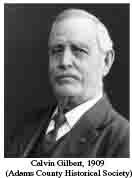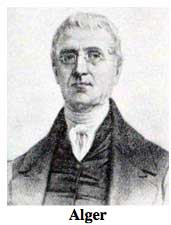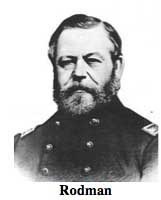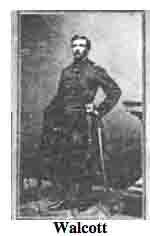
There are hundreds of cannons at Gettysburg, many of them flanking monuments and markers. Such is the case with this artillery piece. The carriage, wheels, limber and other tube carrying mechanisms all look well tended to and in good shape, sporting what appears to be fresh paint. The firing tube has a green patina from constant exposure to the elements. I peered into the bore and did not observe any rifling grooves, making this a smoothbore. The muzzle stamp on this one is a worn and battered and identification was somewhat difficult but of all things the registry number actually still was visible. I learned the man who made the tablets which accompany the cannons also had a hand in restoring these cannons as well. Gettysburg National Military Park has hundreds of these historic artillery pieces on its field of battle. Their carriages, sights, limbers and caissons, however, have been restored. Much of the restorative work came from Major Calvin Gilbert who owned the Gettysburg foundry.

Calvin Gilbert owned a Foundry which bore his name in Gettysburg. This man was responsible for creating all of the cast iron battery tablets. His work did not end there as his foundry created many of the carriages for the historic cannons at Gettysburg. Although almost all of the cannons are from the Civil War, their carriages, sights, limbers, wheels and caissons have been restored at his foundry in the early part of the 20th century. Gilbert was in his 70s when he did this work and completed work at other battlefields as well.
The Napoleon guns and the  3rd Massachusetts Battery Monument are located on Wright Avenue, on the right or northeast side of the road if traveling southwest along the Avenue. This is the first monument on Wright Avenue. The guns are 568 feet from the intersection of Taneytown Road (Route 134) and Wright/Howe Avenues. As a point of reference, at the intersection, a left turn is Wright Avenue and a right turn is Howe Avenue, even though they are the same road, if traveling north. The tablet is flanked by these two 12-pounder Napoleon smoothbore guns, both pointing south southwest presumably in the direction of the once advancing enemy. If facing the tablet, the gun on the left is registry #86 from the Alger foundry and the gun to the right is registry #178 from the Revere foundry. Parking is on Wright Avenue. Stay off the grass or anything green or you will be ticketed by the Park Police. I visited this site on Monday, July 1, 2013 on the 150th anniversary of the Battle of Gettysburg @ 1:26 PM, EDT & @ an altitude of 516 feet, ASL. As always, I used my trusty and oft abused Canon PowerShot 14.1 Megapixel, SX210 IS digital camera for the photos.
3rd Massachusetts Battery Monument are located on Wright Avenue, on the right or northeast side of the road if traveling southwest along the Avenue. This is the first monument on Wright Avenue. The guns are 568 feet from the intersection of Taneytown Road (Route 134) and Wright/Howe Avenues. As a point of reference, at the intersection, a left turn is Wright Avenue and a right turn is Howe Avenue, even though they are the same road, if traveling north. The tablet is flanked by these two 12-pounder Napoleon smoothbore guns, both pointing south southwest presumably in the direction of the once advancing enemy. If facing the tablet, the gun on the left is registry #86 from the Alger foundry and the gun to the right is registry #178 from the Revere foundry. Parking is on Wright Avenue. Stay off the grass or anything green or you will be ticketed by the Park Police. I visited this site on Monday, July 1, 2013 on the 150th anniversary of the Battle of Gettysburg @ 1:26 PM, EDT & @ an altitude of 516 feet, ASL. As always, I used my trusty and oft abused Canon PowerShot 14.1 Megapixel, SX210 IS digital camera for the photos.
My SOURCE for all things weapons at Gettysburg provided me with information I could read on the muzzle as well as registry information that was too worn to read. There is also additional data which does not appear on the muzzle and I used red to designate that data. The rest is as it exactly as it should appear on the muzzle, starting at the top, 12 o'clock position and moving clockwise.
Alger ......1219 ......1862 ......T.J.R. ......No. 86 ......FDY #1112
Registry Information Explanation
Alger stands for the Cyrus Alger Foundry out of Boston, MA and the foundry responsible for producing this weapon. 1219 lbs represents the total weight of the bronze firing tube which was very heavily in comparison to the lighter and newer 3-inch ordnance rifle of 1861 which weighed about four hundred pounds less than the Napoleon and was just as accurate and deadly. 1862 is the manufacture date which means in this year the foundry were still producing the older 1857 design from seven years earlier. T.J.R are the initials of an unbelievably famous (and somewhat controversial) Union Ordnance Officer responsible for inspecting the cannon before the Union Army took possession of it. No. 86 is the registry or registration number, a way for the army to keep track of its weapons obtained from the foundry's commissioned to do so. FDY #1112 is an internal control number specific to the foundry. As required by Federal regulations, the foundry stamped a control number – independent of the registry number – on the right rim base of these type of guns. This was to aid in tracking casting sequence. One of my sources [To The Sound of the Guns] speculates foundry numbers were issued to rejected castings that, having failed inspection, did not receive registry numbers.
About the Foundry
This armory was founded by Cyrus Alger (born in West Bridgewater, Massachusetts, 11 November 1781; died in Boston, 4 February 1856), Alger was a United States arms manufacturer and inventor.  Early in life he became an iron founder, and established his business in Easton, Massachusetts. In 1809 he moved to South Boston, where he founded the works that since 1817 were known as the South Boston Iron Company. He supplied the government with large numbers of cannon balls during the War of 1812, and his works became famed for the excellent ordnance there manufactured. He was one of the best practical metallurgists of his time, and his numerous patents of improved processes show continued advance in the art practiced by him. The first gun ever rifled in America was made at his works in 1834, and the first perfect bronze cannon was made at his foundry for the U. S. ordnance department, The mortar “Columbiad,” the largest gun of cast iron that had then been made in the United States, was cast under his personal supervision. SOURCE To date many Cyrus Alger cannons are collection pieces in museums, on battle fields, at memorials, monuments and reproduction models made for Civil War re-enactments.
Early in life he became an iron founder, and established his business in Easton, Massachusetts. In 1809 he moved to South Boston, where he founded the works that since 1817 were known as the South Boston Iron Company. He supplied the government with large numbers of cannon balls during the War of 1812, and his works became famed for the excellent ordnance there manufactured. He was one of the best practical metallurgists of his time, and his numerous patents of improved processes show continued advance in the art practiced by him. The first gun ever rifled in America was made at his works in 1834, and the first perfect bronze cannon was made at his foundry for the U. S. ordnance department, The mortar “Columbiad,” the largest gun of cast iron that had then been made in the United States, was cast under his personal supervision. SOURCE To date many Cyrus Alger cannons are collection pieces in museums, on battle fields, at memorials, monuments and reproduction models made for Civil War re-enactments.
About the Inspector
Thomas Jackson Rodman (July 31, 1816 – June 7, 1871) was an American artillerist, inventor and innovator, ordnance specialist, and career United States Army officer.  He served as a Union Army general during the American Civil War, in which he was noted for his many improvements and innovations concerning the artillery used by the Union forces. Rodman worked many armories including Alger, Hooper & Revere, to name a few. Throughout the American Civil War, Rodman was commander and superintendent of the Watertown Arsenal, located along the Charles River in Watertown, Massachusetts. As the American Civil War ended in 1865, Rodman was rewarded for his service with three brevet promotions in the U.S. Army, all occurring on March 13, making him a brevet brigadier general. On March 7, 1867, Rodman was promoted to the permanent rank of lieutenant colonel in the U.S. Army. He died on duty at Rock Island on June 7, 1871, and was buried on June 17 in the arsenal's National Cemetery. SOURCE
He served as a Union Army general during the American Civil War, in which he was noted for his many improvements and innovations concerning the artillery used by the Union forces. Rodman worked many armories including Alger, Hooper & Revere, to name a few. Throughout the American Civil War, Rodman was commander and superintendent of the Watertown Arsenal, located along the Charles River in Watertown, Massachusetts. As the American Civil War ended in 1865, Rodman was rewarded for his service with three brevet promotions in the U.S. Army, all occurring on March 13, making him a brevet brigadier general. On March 7, 1867, Rodman was promoted to the permanent rank of lieutenant colonel in the U.S. Army. He died on duty at Rock Island on June 7, 1871, and was buried on June 17 in the arsenal's National Cemetery. SOURCE
About the Gun
The twelve-pound cannon "Napoleon" was the most popular smoothbore cannon used during the war. It was named after Napoleon III of France and was widely admired because of its safety, reliability, and killing power, especially at close range. The Federal version of the Napoleon can be recognized by the flared front end of the barrel, called the muzzle-swell. Confederate Napoleons were produced in at least six variations, most of which had straight muzzles, but at least eight catalogued survivors of 133 identified have muzzle swells This bronze gun does not have that flare. Casting of these bronze Napoleons by the Confederacy ceased due to lack of resources and in January 1864 Tredegar began producing iron Napoleons. Just before this in early 1863, resources were so scarce, Robert E. Lee sent nearly all of the Army of Northern Virginia's bronze 6-pounder guns to Tredegar (another foundry) to be melted down and recast as Napoleons. SOURCE
Commonly referred to as the "Napoleon", this bronze smoothbore cannon fired a twelve-pound ball and was considered a light gun through each weighed an average of 1,200 pounds. This powerful cannon could fire explosives shell and solid shot up to a mile and charges of canister up to 300 yards with accuracy. The Napoleon was a favorite amongst some Northern artillerists because of its firepower and reliability. Two Union batteries armed with Napoleons at Gettysburg were very effective in holding back Confederate infantry attacks and knocking down opposing southern batteries. Battery G, 4th U.S. repeatedly slowed Confederate infantry attacks against the Eleventh Corps lines on July 1, while Captain Hubert Dilger's Battery G, 1st Ohio Light Artillery almost annihilated two Confederate batteries with accurate and punishing counter-battery fire at long distance. Most Union Napoleons were manufactured in Massachusetts by the Ames Company and the Revere Copper Company. SOURCE
12-pounder bronze gun, Model of 1857 Specifications
| Tube Material |
Bronze |
| Tube Weight |
1,227 lb (557 kg) |
| Powder Charge |
2.5 lb (1.13 kg) |
| Range (5° Elevation) |
1,619 yd (1,480 m) |
| At Gettyburg |
142 |
About the Battery
The 3rd Massachusetts Artillery Battery C was also known as Martin’s Battery. During the battle of Gettysburg, it served as a member of Martin’s Brigade in the Fifth Corps, Army of the Potomac.  The battery was commanded at the Battle of Gettysburg by Lieutenant Aaron Francis Walcott (1836 - December 11, 1907), previously, a bookkeeper from Boston. Walcott enlisted April 25, 1861 and mustered in on July 31, 1861. He mustered out on September 16, 1864 but then re-enlisted and drilled the battery in Boston. In 1869 and 1870 he was a merchant tailor, then he went into the real estate business, staying in Boston. IN 1872, he moved to Chicago, continuing real estate an also the storage business. In 1900 he returned to Massachussets and lived in Melrose. While in Chicago he served as a deputy sheriff of Cook County for 8 years. Under Walcott's command the unit brought 124 men to the Gettysburg Battlefield operating 6 Napoleons. There was a total of 6 casualties.
The battery was commanded at the Battle of Gettysburg by Lieutenant Aaron Francis Walcott (1836 - December 11, 1907), previously, a bookkeeper from Boston. Walcott enlisted April 25, 1861 and mustered in on July 31, 1861. He mustered out on September 16, 1864 but then re-enlisted and drilled the battery in Boston. In 1869 and 1870 he was a merchant tailor, then he went into the real estate business, staying in Boston. IN 1872, he moved to Chicago, continuing real estate an also the storage business. In 1900 he returned to Massachussets and lived in Melrose. While in Chicago he served as a deputy sheriff of Cook County for 8 years. Under Walcott's command the unit brought 124 men to the Gettysburg Battlefield operating 6 Napoleons. There was a total of 6 casualties.
The primary monument for the 3rd Massachusetts Battery Monument can be found  HERE. That monument is located is south of Gettysburg on Wheatfield Road near the Weikert Farm Lane.
HERE. That monument is located is south of Gettysburg on Wheatfield Road near the Weikert Farm Lane.
The monument and guns, recalls the service of the t3rd Massachusetts Battery C for July 3, 1863. The inscription reads:
 Army of the Potomac
Army of the Potomac
Fifth Corps Artillery Reserve
Battery C
Massachusetts Light Artillery
Six 12 pounders
Lieut. A.F. Walcott commanding
July 3 At 3 a.m. moved to and occupied this position until the close of the battle.